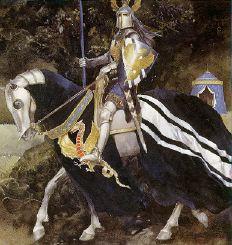Ok, ok, I really like this show. Twenty-six cases with dollar amounts between $.01 and $1,000,000. The contestant picks one and then begins a process of elimination by opening up the non-selected cases in groups of 6, 5, 4, 3, 2 and then 1. Clearly what is opened in the non-selected cases cannot be in the selected case. As each amount is revealed, the potential value of the selected case changes, going up when low values are revealed, and down when high values are revealed. After each group is opened, a shadowy figure in a skybox, called the banker, telephones down an offer to buy the selected case. The name of the show comes from the question asked the contestant after each offer. Deal, take the money, or No Deal, open the next group of cases.
That’s the basics, but it’s the surrounding atmosphere that whips things into a frenzy. There is the company of 26 young ladies in matching (usually short and low cut) dresses that possess the cases, open the cases and then leave the stage after their case is opened. The show wouldn’t be the same without them. Not only are they very easy on the eyes, but they add a human touch, being happy when the contestant opens a small number and sympathetic when a big number is revealed.
The contestant gets to bring moral support. Usually the support consists of three family members or friends that hang out in a separate area of the stage and give advice as to whether or not the deal should be accepted. One lady brought an opera singer friend that sang to the banker and another a dozen or so kids from her class that the show decked out in "Deal, or No Deal" tee shirts.
The show throws in a twist occasionally just to keep you off balance. On one show, rather than offering money, the contestant, an unrepentant Cowboy fan, was offered a Cowboy season ticket dream package complete with limousine service to and from the game. On another show the marching band of the contestant’s Alma Mater showed up to give support, on another, one deal included a pony for the contestant's little girl and on another, one of the models holding the cases was actually the contestant’s sister which neither the contestant, nor her mother in the support section, noticed despite blatant hints.
Then there’s the audience, a collection of pit vipers in stadium seating that remind me of the spectators at a gladiatorial contest! Talk about wanting blood! No deal is ever good enough for them!
Keeping this circus under control is Howie Mandel as the MC and Howie does a masterful job. For the rest of his life Howie will be hearing “Deal, or No Deal.” Mandel’s timing has never been better. He even uses the commercial breaks to crank up the tension by delaying opening a case, or letting the contestant in on the size of the latest offer, until “right after this.” Mandel also does a pretty good “keep your chin up” job when things go wrong such as telling one guy “hey, this is a once in a lifetime opportunity so don’t feel bad about taking your shot.”
As for the offers, I don’t think there’s a precise formula. The banker seems to have some leeway but in general the offers seem to be a percentage of the mean value of the board with the percentage growing the deeper into the game things are. For example, after the first round, the offers seem to be about 10% to 15% of the mean. Later in the game, the offers approach the mean.
I doubt that anyone will ever win the $1,000,000. That would take picking the right case, a 1 in 26 chance, and then either taking an enormous risk late in the game or managing to keep several of the big numbers in play in order to keep the risk under control late in the game. Still, we’re talking serious money here and serious risk. The other night a young woman had a four case board with $300,000 the high value and the next highest value down around $300. Despite EVERYONE (except the vipers in the audience of course) telling her to take the deal of $71,000 (which was pretty darn close to the mean of about $75,000) she turned it down. She opened the case with $300,000 and eventually left with only $50.
The board starts with a mean of around $131,000. The largest amount I’ve seen won was $340,000 and the smallest the $50 from the example above. I’ve heard that the record is over $400,000 on the high end and $5 on the low end. People do get greedy. Another woman managed to go from $299,000, to about $140,000, to about $60,000 to $25,000 by opening up the three largest remaining values in a row.
I’m seen some people bemoan the premise of the show because it requires no knowledge or talent to participate and win. That’s what I like most about the show. It’s totally random. EVERYBODY is equal. Who could ask for a more democratic environment? In the world of Deal or No Deal, the klutz is equal to the world class athlete and the high school dropout equal to the guy with multiple PhDs. One lady, who claimed to have an advantage because she was psychic, walked away with a lot less than the initial mean of $131,000 so, technically, she lost. So much for her advantage (although I think she managed about $91,000 which ain’t bad).
I probably could be doing much more important things than watching this show, but I wouldn’t be having as much fun.
Friday, May 19, 2006
Subscribe to:
Post Comments (Atom)


1 comment:
Have you seen the SNL bit on Deal or No Deal? It's here.
Post a Comment